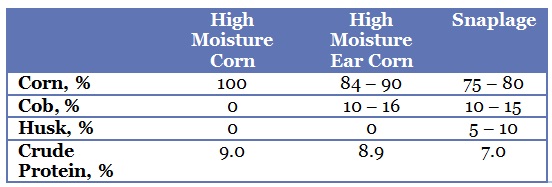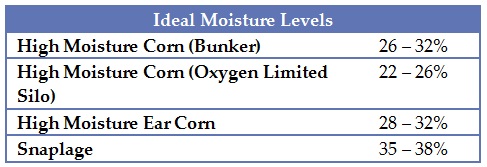The popularity
of high moisture corn and high moisture ear corn has been consistent for some
time. Snaplage has had renewed interest as harvesting equipment, like snapper
heads and kernel processors, have improved. Each of these has their advantages
and disadvantages which should be weighed against what is feasible for your
operation and what your specific goals are.
As the name
would imply, high moisture corn is corn harvested before the kernels have dried
down. Harvest usually occurs between corn silage and dry corn. It is typically
processed by a roller or hammer mill, packed into an appropriate structure, and
allowed to ferment. High moisture ear corn is similar; however, it includes a
portion of the cob. Snaplage includes the kernels, cob, and husk. See chart for
dry matter compositions of these feeds. When harvesting these types of feeds,
consider the use of a forage inoculant to increase feed value and decrease
losses.

Pros
and Cons
One item to be aware of is that these
feeds are highly fermentable in the rumen. This may increase the likelihood of
acidosis under certain conditions. Some overall advantages and disadvantages of
using snaplage, high moisture corn and ear corn are:

While high
moisture corn is a great feed, it does have its disadvantages over high
moisture ear corn and snaplage. First, tonnage harvested is lower for high
moisture corn because it is solely the kernel being used. In only using the
kernel, the digestible and effective fiber is also lost. The fiber provided by
the corn cob and husk help to prevent the occurrence of ruminal acidosis. It
also helps to reduce the amount of forage that needs to be included in the
ration to maintain rumen health. Harvesting high moisture corn gives the advantage
of avoiding the mycotoxin concentration within the cob portion. If corn is moldy
or damaged, avoid harvesting it as ear corn or snaplage. Also, less storage
space it required for high moisture corn as compared to ear corn or snaplage;
there is no extra volume coming from the cob or husk.
Maximizing
the Harvest
Appropriate
moisture levels are critical when harvesting and ensiling high moisture corn
feedstuffs. Because the corn cob contains higher moisture than the kernel, high
moisture ear corn and snaplage should have higher moisture levels than that of
high moisture corn. Moisture level is of particular concern in high moisture
ear corn and snaplage because digestibility of the cob decreases dramatically
as it matures and dries. Moisture testers are available to estimate the
moisture of the corn grain. Typically, snaplage will have a moisture value 5%
higher than high moisture corn. Ideally, harvest snaplage when the corn grain
tests 28% moisture.

High moisture
corn can be stored in upright or bunker silos in either a whole or ground form.
Commonly, whole high moisture corn is stored in upright silos. If stored in a
bunker silo, it should be ground. There is no advantage of grinding high
moisture corn other than for storage in a bunker silo. To ensure adequate
packing and better animal intakes, cob fraction of high moisture ear corn
should be ≤ ½ inch.
Feedout
It was
originally believed that starting cattle out on high moisture corn was
difficult due to the risk of ruminal acidosis. However, thanks to the increased
use of lower-starch corn coproduct feeds, this risk has been minimized.
Utilizing corn distillers or corn gluten feed programs with high moisture corn
may be more economical than the typical corn pellet diet. Combinations of dry
and high moisture corn can yield 5 – 10% greater weight gain and feed than when
fed individually. Feeding value of high moisture ear corn is about 6 – 10%
higher than dry ear corn. Both snaplage and high moisture ear corn provide
additional fiber help meet roughage needs of growing cattle.
Prime Cuts: Consideration for High Moisture Corn, Ear Corn and Snaplage
Famo Feeds • 446 Industrial Dr • Freeport, MN • 800-450-2145

